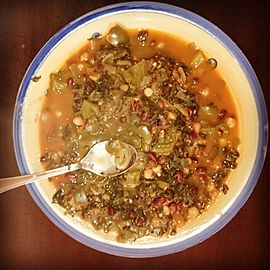Githeri facts for kids
 |
|
| Alternative names | Succotash, muthere or mutheri |
|---|---|
| Course | Main course |
| Place of origin | Kenya |
| Region or state | Any region |
| Serving temperature | Hot |
| Main ingredients | Sweet corn, Red Beans, black beans, maize lima beans, butter, salt |
Githeri (Gĩtheri), also known as muthere or mutheri, is a traditional Kenyan meal. It is made by mixing and boiling maize (corn) and legumes, usually beans, together. You put the maize and beans in a pot, add water, and boil them until they are cooked and ready to eat.
Githeri is a very important food for the Gikuyu, Meru, Mbeere people, and Embu people in the Central and Eastern parts of Kenya. It is also popular in other areas and among other groups, like the Kamba people. People can use either fresh or dry maize and beans. Many prefer fresh ingredients because they are softer and taste better. It's easy to find the ingredients since they often come straight from local farms.
Contents
What is Githeri?
Githeri is a simple but tasty dish. It is made from two main ingredients: maize and beans. These are boiled together until they are soft. Sometimes, people add just a little salt for flavor. It's a filling meal that gives you lots of energy.
How Githeri is Eaten
Githeri can be enjoyed in different ways. You can eat it plain, right from the pot, with just salt added. This is sometimes called murugarugio.
You can also turn Githeri into a stew. To do this, you add vegetables like potatoes, and sometimes even meat. This makes it a richer, more complete meal. Githeri is also used to make another popular dish called mukimo. For mukimo, potatoes, bananas, and green vegetables are added to the Githeri, and then the whole mixture is mashed up.
Why Githeri is Popular
Githeri has become very popular, especially because it is a healthy, plant-based meal. It has been a main meal for students in Kenya since the 1920s. This long history has made it a favorite for many young people today. You can even find Githeri served in many hotels across Kenya.
Similar dishes made from maize and beans are eaten in many other parts of Africa. From Ethiopia all the way down to South Africa, people enjoy meals like Githeri, though they might call them by different names. For example, in Tanzania, it can be known as Kande, Pure, or Ngate. This shows that Githeri is a dish with a much bigger story than just Kenya!
Different Names for Githeri
People in different parts of Kenya and Africa have special names for Githeri or similar dishes. Here are a few:
Kikuyu Language
- murugarugio – Githeri served directly from the pot with only salt. The name comes from a word meaning "moving up and down," like shaking the plate.
- gikangu – Cold Githeri that has more maize than beans.
- kagoto – A slang name for Githeri, meaning "ballast," used by students.
- mbeu – Means "seeds," because Githeri contains whole maize and beans.
- mukimo – Githeri mixed with potatoes, greens, and bananas, then mashed.
- muthungu – Githeri made only from maize, without beans. Muthungu means "the white man," fitting for a dish full of white maize seeds.
Kamba Language
- isyo – A general name for Githeri.
- mukeu – Githeri made with fresh (undried) corn and beans.
- muthokoi – Githeri where the outer skin of the corn kernel has been partly removed.
Luo Language
- nyoyo – A common name for Githeri in the Luo language.

